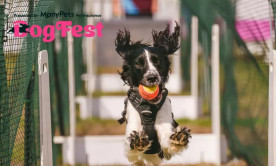Like their owners, every dog has its own personality complete with odd little behaviours. Here is a quick overview of some of the less common behaviours your dog might do and what they could mean:
Digging
Digging is a very natural behaviour for dogs. Wild dogs, and the canine relatives of domestic pets such as wolves and foxes, often dig dens and holes for shelter.
They also dig to bury items. Again this is a natural and vital behaviour in the wild that domesticated dogs also sometimes do. In the wild, dogs do this to store food, but pets will also do this for entertainment and can bury and uncover an item multiple times.
Although it can be annoying if your dog is destroying your garden, it is a sign that the dog is eager to use energy and is in good health. However, excessive digging can become destructive and can be a sign of other issues including, having too much energy, boredom or, if the dog lives outside, wanting to create shelter.
Try playing with your dog more, using tug toys and bite pads, or take them for longer walks in order to use-up excess energy.
If your dog is mostly kept outdoors then it may be digging to find a warmer or cooler place to rest. Ensure the dog house is shaded and is offering your dog adequate protection from the elements.
Excessive Circling
A dog running around in circles is a common behaviour. Some dogs do it before sleeping while some do it out of excitement when their owner returns home. However, excessive circling can be a sign of anxiety or more serious health issues.
In older dogs, regular and impulsive spinning, pacing and circling could be a sign of problems with their memory, eyesight or hearing. It could also be a sign of other health issues including liver disease, Cushing’s disease or tumours.
If think your dog is behaving oddly, then you should always make an appointment with a veterinarian. Recording a video of their circling can help the vet have a better understanding of the issue.
Walking Between Your Legs
Some dogs like to walk through their owner’s legs for attention. Other times it can be a sign that the dog is scared or anxious. This fear can come from unfamiliar locations while out for a walk, or it could be to avoid petting from other people.
Other times it can simply mean your dog has a scratch it wants to itch or it could be a greeting.
If think your dog is being anxious, or showing other signs of anxiety such as shaking, excessive licking or excessively pulls on the lead, then you should seek advice from a vet.
Scooting
Scooting is when your dog drags its backside across the floor. This behaviour is usually caused by the dog having a sore bottom and wants to relieve the pain.
One off and irregular scoots could just be an itch the dog is trying to scratch, but repeated scooting can be a sign of a more serious issues like an impacted anal gland.
If the anus looks sore or inflamed, then this could be a sign of a blocked anal gland and you should make an appointment with your vet as soon as possible.
Coprophagia (eating faeces)
A dog eating its own poo is of course quite off putting, but it also harmless and not that uncommon. However, health problems can arise if a dog eats another dog’s faeces or another animal’s. This is due to stools containing contaminants the dog is not used to, such as viruses or toxins passed on through the digestion process.
Dogs that eat faeces often do it for attention, so it is important not to accidentally reinforce this behaviour by making too much fuss of them.
If you regularly feed your dog near where they defecate then this can cause the dog to become confused between the two smells and associate their poo as dinner.
The dog may also not be getting enough vitamins and nutrients in their everyday diet and are looking for nourishment. Speak to your vet about your dog’s eating habits and possible supplements that could be introduced into their diet.
Humping After Nurturing
Spaying or nurturing a dog won’t completely irradiate its sex drive. Due to this, many dogs, both male and female, still hump or mount objects, other dogs, and sometimes even other animals.
Humping is not always sexual for dogs. Sometimes a dog will hump objects out of excitement (like when owner’s return home), to display dominance, or to gain attention.
Humping is still quite common for newly neutered or spayed pets as their hormones levels are still decreasing. Dogs under a year old have also had less time be disciplined against the behaviour.





